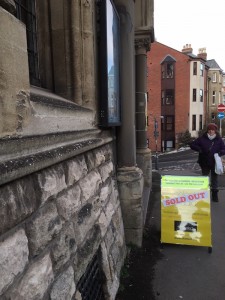Prof Anita Taylor
Feb 2019
SitSelect, Centre for Science & Art, Stroud
THE INSISTENCE OF DRAWING
It took three hours driving, a day after the big snow halt on the M4 and A34, with relative ease.
The centre is the old (Gloucestershire) art college with herringbone wooden floor tiles, high ceilings, wide and shallow stairs. It smelled of, well, old college. The studios were open so the nearest description I can offer is a mix of old school and oil paint. Pleasing.
I met Nicola Grellier (http://nicolagrellier.co.uk/) currently MA student at UWE, Kerry Phippen, (https://kerryphippenart.com/) and Lizzie Walton (SitSelect Director http://www.sitselect.org/).
If anyone is interested in studio spaces and lives in the area contact Lizzie.
Who is Anita? She is a practicing artist, a Professor and Executive Dean of Bath School of Art and Design at Bath Spa University, founder of Drawing Projects UK and founding Director (since 1994) of Trinity Buoy Wharf Drawing Prize (formerly Jerwood Drawing Prize), the preeminent annual open exhibition for drawing in the UK, which arose from a need to understand how and what artists were drawing at that time.
She began talking about her background, and about what drawing is, describing drawing as about
being the world…
about understanding and integrating the view with the being
about looking in the mirror and seeing what you feel
about combining technical with emotional drawing
in her work she draws ideas that are on the cusp of being
that are about to become rather than that are of doing
She describes her work as ‘set in the tradition of women drawing themselves… [and] of gestures that convey emotion’
She says that drawing occupies space – but it also occupies the understanding of space
Anita likes to push the limits of representation in her self-portrayal drawings, allowing for a level of expression and of engagement with the viewer. There is an element of the ‘witness’ in the work.
She went on to explain the importance of drawing and how it became somewhat lost in the 80s and 90s, when commercial galleries didn’t show many drawings. It was because of this lack that she set up the open exhibition as part of a professional practice unit for 30 students to raise the profile of drawing, to create dialogue around drawing, and to give prizes to support artists in meaningful ways. It was set up with a grant and was a huge success, continuing supported in partnership with Jerwood, and now Trinity Buoy Wharf Drawing Prize (http://trinitybuoywharfdrawingprize.drawingprojects.uk/index.php/about/about-the-trinity-buoy-wharf-drawing-prize)
Returning to the subject of drawing Anita then gave us a visual tour of artists who have exhibited through the programme, identifying different aspects in drawing, each one a gem for discussion:
Drawing to
Document
Measure the world
Understand the world
Find your way in the world
Three dimensional drawings
Drawing acts
Drawing to slow time
Drawing in the landscape
Drawing with paint
Drawing performance with a piece of chalk bigger than a rugby ball
Drawing with the reach of the human body
Drawing that is disrupted – intervened by rain
Drawing what it feels like to be observed
Drawing archaeology to document everything in your grandfathers shed
Drawing as a private act
Drawing as a capacity to discuss politics
Drawing to replace what was lost or not valued
Drawing colour
Drawing relationships
Drawings things we cannot make
Remaking a drawing
Drawing that gouges into or through a surface
Drawings made with things embedded
Drawings that layer
Drawings that make meaning intense
Drawing as an imprint
Drawings of people we don’t want to think about
Nailhouse drawings
Drawings with shadow to articulate a space
Drawing with human hair
Drawing with sound
Drawing community through doing together
Drawing form
Materiality of drawing
Drawing mediums of meaning
Drawing as process
Through the Q+A session that followed, she invited us to consider creating a drawing space, the space in you to draw as well as around you, and of the time to draw. Anita uses a live/work space that makes it easier for her to stop.start.draw.
Artists highlighted (and well worth looking up):
Stephen Farthing
Chris Barnes
Juliet Lose
Gerry Davies
Gerhard Schon
Neville Gabie
David Connearn
Brighid Lowe
Claude Heath
Lee John Phillips
Andrew Grant
Wendy Sharpe
Barbara Walker
Sally Taylor
Emma Talbot
Ed Allington
Paul Ryan
Emma Douglas
Sian Bowen
Gary Lawrence
Jen Wei-Kuo
Caroline Burraway
Laura Hudson
Andy Bannister
Joan Jonas
Sheila Gowda
Alison Carlier
